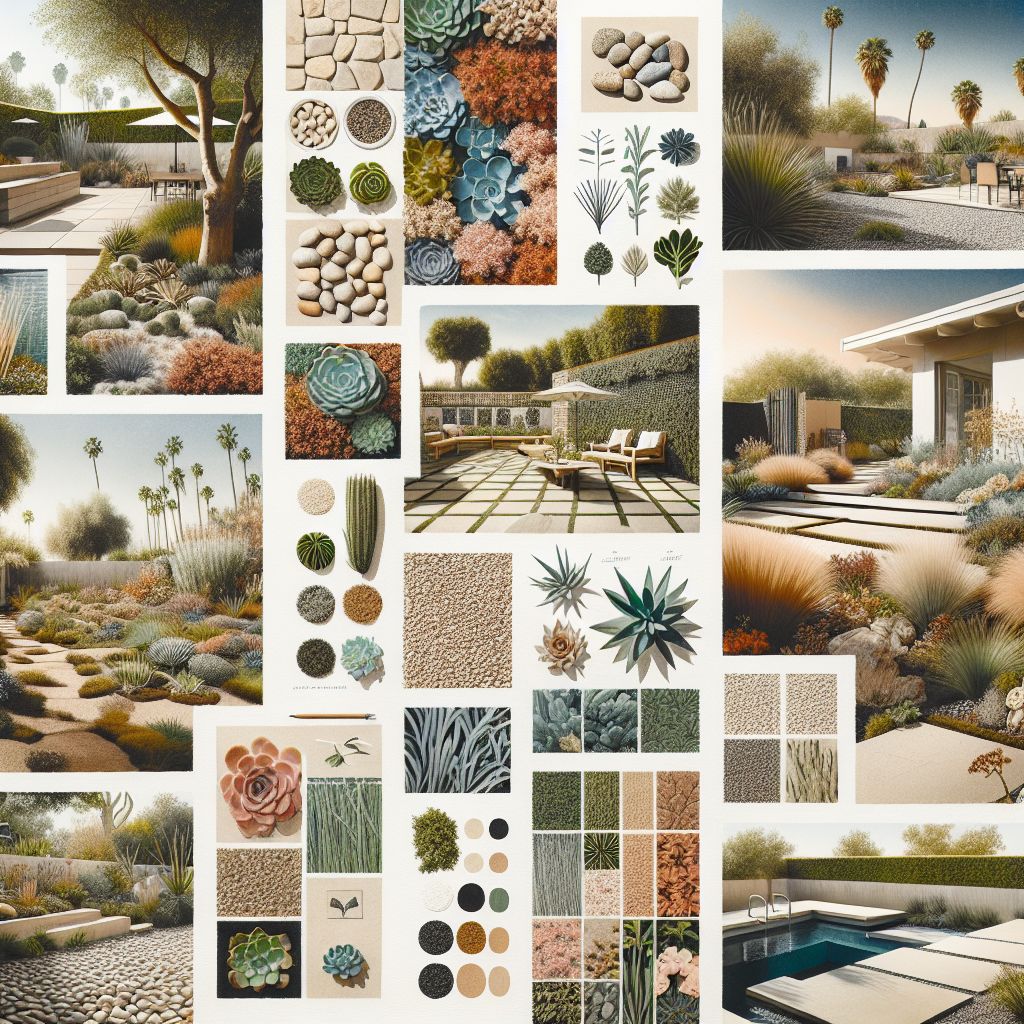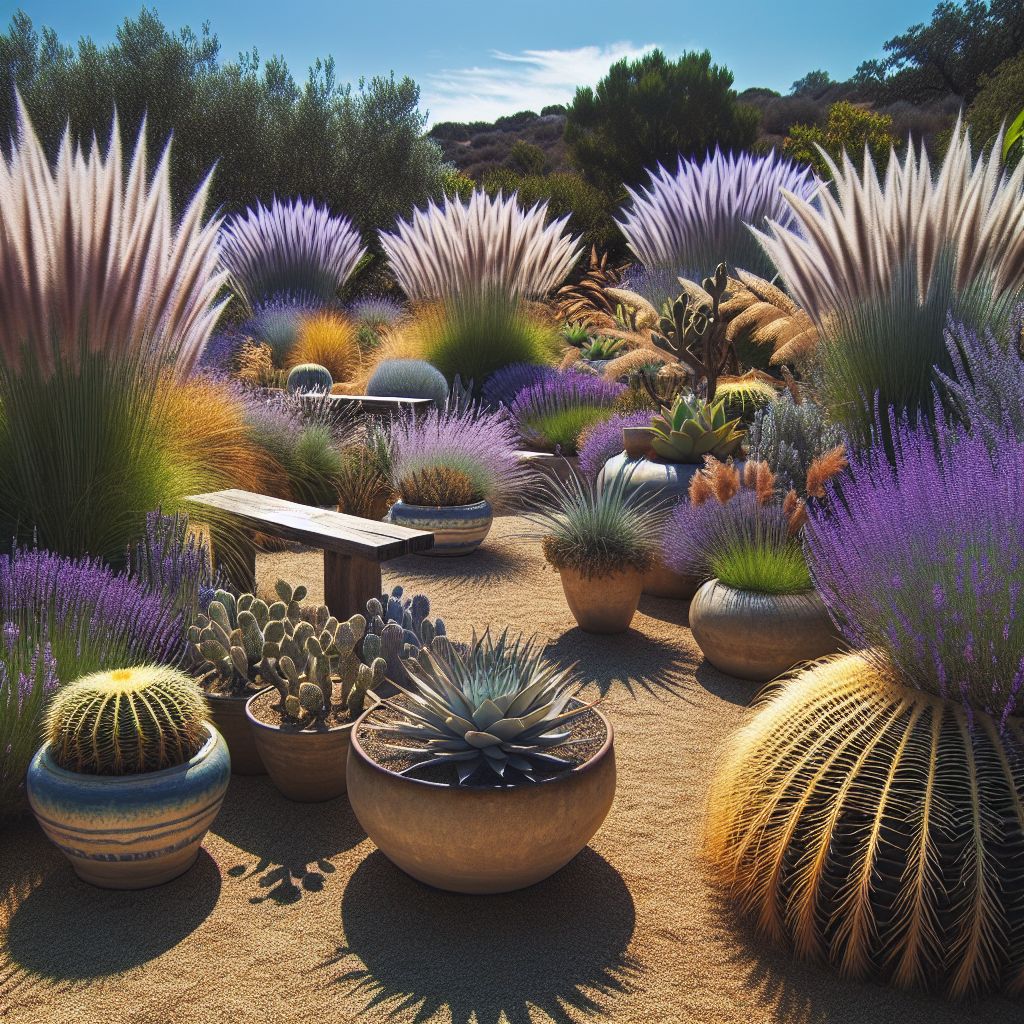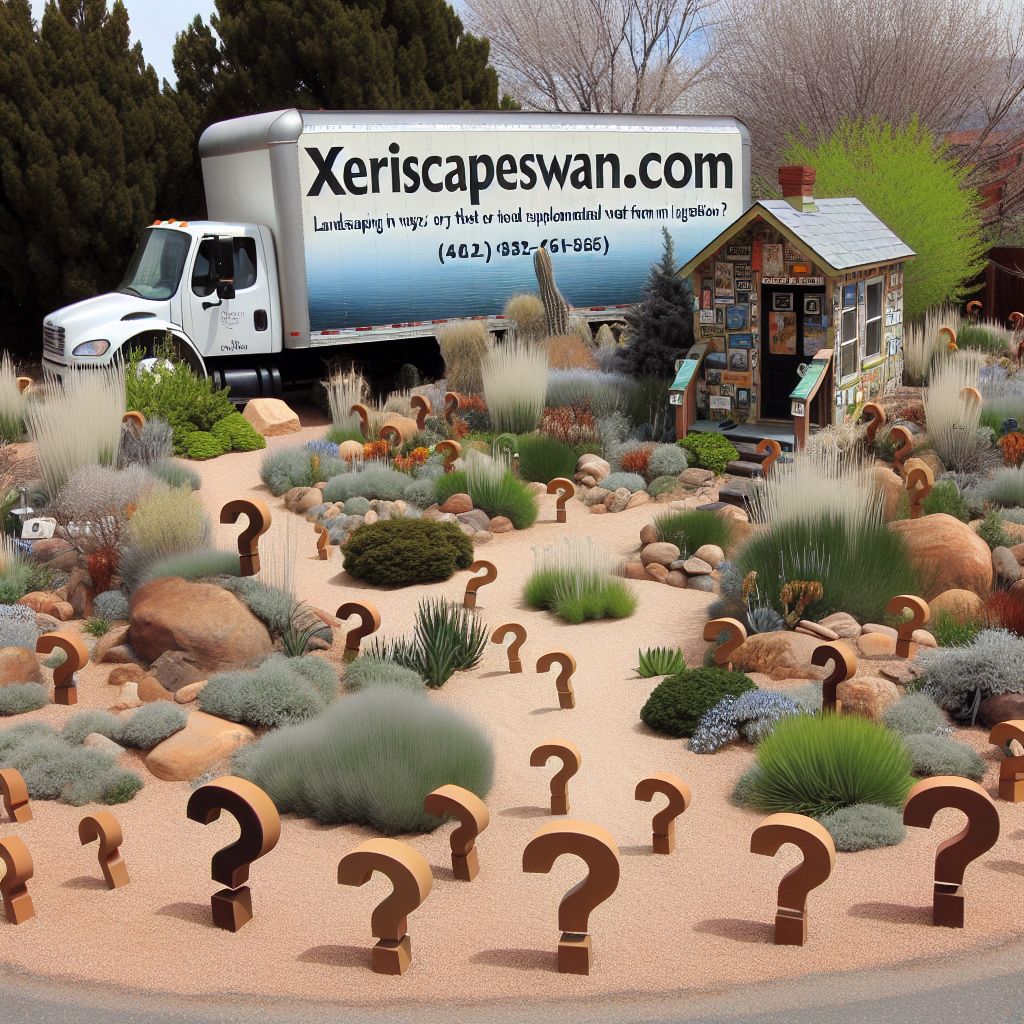
Article-at-a-Glance
- Drought-resistant landscaping conserves water and withstands dry climates, making it ideal for Los Angeles homeowners.
- Selecting native plants and using sustainable materials creates an eco-friendly garden that’s both beautiful and low-maintenance.
- Understanding the specific needs of drought-resistant plants, like water requirements and sunlight exposure, ensures a thriving yard.
- Efficient irrigation systems, such as drip irrigation, are crucial for water conservation in drought-prone areas.
- Incorporating hardscaping and choosing the right plants can result in a modern, stylish landscape that enhances property value.
The Essentials of Drought-Resistant Yard Design in Los Angeles
Why choose drought-resistant landscaping? Because in a place like Los Angeles, where water is precious and restrictions are common, it makes perfect sense. This approach to yard design not only conserves water but also cuts down on your maintenance time and costs. It’s a win-win for both you and the environment.
Why Drought-Resistant Landscaping?
Most importantly, drought-resistant landscaping aligns with the local climate. It uses plants and materials that are adapted to dry conditions, meaning they’ll thrive with minimal water. This isn’t just about surviving the next drought; it’s about creating a landscape that’s resilient for years to come.
Eco-Friendly Materials and Practices
Besides that, choosing the right materials is key. Opt for permeable paving options like decomposed granite or gravel that allow rainwater to seep into the ground, reducing runoff and promoting soil health. And don’t forget mulch—it’s not only great for conserving soil moisture but also for preventing weeds.
Choosing the Right Drought-Resistant Plants
When selecting plants, consider those native to
List of Drought-Resistant Plants
Here’s a quick list of some drought-resistant plants perfect for Los Angeles gardens:
- California Poppy: The state flower, it brings a pop of color and is self-seeding.
- Salvia: With various species to choose from, these sages offer beautiful blooms and fragrant foliage.
- Manzanita: Known for its attractive bark and delicate flowers, it’s a great choice for adding structure to your landscape.
- Deer Grass: This ornamental grass is perfect for creating a natural, meadow-like feel.
- Ceanothus: Also known as California lilac, its blue flowers are a magnet for bees and butterflies.
Understanding Water Needs
Even drought-resistant plants have different water needs. Grouping plants with similar water requirements together makes it easier to manage your garden’s hydration without overwatering. This practice, known as hydrozoning, is a smart way to design your landscape for efficiency.
Assessing Sunlight Requirements
Just like water, sunlight is a critical factor for plant health. Full sun, partial shade, full shade—each plant has its preference. Position your plants in areas where they’ll receive the right amount of light. This not only ensures they’ll grow well but also helps conserve water since plants in too much sun may require more water than necessary.
Soil-Type Considerations
Soil type matters, too. Some plants prefer fast-draining sandy soil, while others do better in clay that holds moisture longer. Test your soil and amend it if necessary to create the ideal environment for your drought-resistant plants.
Remember, the goal here is to craft a landscape that fits seamlessly with Los Angeles’s unique environment. By doing so, you’re contributing to water conservation efforts and setting an example for eco-friendly living in our city.
Plant Longevity and Sustainability
Choosing plants for your drought-resistant landscape isn’t just about what survives now—it’s about what will thrive for years. Opt for perennials over annuals to get more bang for your buck. Perennials like
Consider the life cycle of each plant. Some may look spectacular in the short term but require replacing every few years. Instead, choose plants that grow stronger and more robust as time goes on. This long-term perspective is essential for a sustainable and cost-effective garden.
Efficient Water Use and Irrigation Techniques
Water is a precious resource, especially in Los Angeles. Efficient use and smart irrigation are the backbones of drought-resistant landscaping. The goal is to give your plants just enough water to thrive, without waste.
Designing Your Irrigation System
Drip irrigation is a game-changer for water conservation. It delivers water directly to the base of each plant, minimizing evaporation and runoff. Install a system with a timer, and you’ll save water and time. It’s a simple setup that pays off with a healthier garden and lower water bills.
Water Conservation Strategies
Water conservation doesn’t stop at irrigation. Collecting rainwater in barrels during wetter months provides an additional supply for the dry season. Also, watering your plants early in the morning or late in the evening reduces evaporation. These small steps make a big difference in maintaining your drought-resistant yard.
Another strategy is to shape the land to direct water flow to plants that need it most. This technique, called ‘grading,’ helps you make the most of the water that does come your way, naturally hydrating your landscape.
Creating a Modern Aesthetic with Drought-Tolerant Features
Now, let’s talk about style. Drought-resistant doesn’t mean dull. With the right design, your yard can be a modern oasis that reflects your personal taste and the latest trends. For inspiration on creating a stylish yet sustainable landscape, explore these drought-tolerant landscaping ideas.
Functional Hardscaping Elements
Hardscaping—using non-plant materials like stone, pavers, and metal—adds structure and style to your yard. A gravel path, a sleek retaining wall, or a decorative patio can transform your space while also reducing the need for water-thirsty grass.
Using Color and Texture in Design
Even without lush green lawns, you can create a vibrant landscape. Play with the textures of different succulents or the rich hues of native shrubs. Add a pop of color with drought-tolerant flowers like California poppies or blanket flowers. It’s all about creating visual interest that draws the eye and delights the senses.
Remember, the goal is to blend form and function, creating a space that’s both beautiful and resilient. A well-designed drought-resistant yard is not only sustainable but also a statement of your commitment to eco-conscious living.
Long-Term Maintenance of a Drought-Resistant Landscape
Once your drought-resistant yard is in place, it’s all about smart maintenance. The beauty of these landscapes is that they require less work than traditional yards, but there are still things to keep in mind for their long-term health.
Seasonal Care and Upkeep
Even drought-resistant plants need some TLC. Pruning at the right time encourages growth and prevents disease. Mulching helps retain soil moisture and keeps roots cool. And don’t forget to periodically check your irrigation system to ensure it’s functioning efficiently.
Managing Weeds and Pests Sustainably
Weeds and pests can be a challenge, but there are sustainable ways to manage them. Hand-pulling weeds is the most eco-friendly method. For pests, opt for natural predators like ladybugs or use organic pesticides sparingly. It’s about working with nature, not against it.
Regular monitoring and a little bit of elbow grease go a long way in keeping your drought-resistant garden healthy. By staying on top of maintenance, you’ll enjoy a beautiful yard year-round with minimal effort and water use.

Cost-Effective Drought-Resistant Yard Design
Creating a drought-resistant landscape is an investment, but it doesn’t have to break the bank. Let’s look at how to keep costs down while building your dream yard.
Estimating the Price of Plants and Materials
When budgeting, consider the cost of plants and materials. Native plants tend to be more affordable and require less care. Bulk purchases of materials like mulch or gravel can also save money. Here’s a quick rundown of typical costs:
- Native plants: $5-$30 per plant, depending on size and species.
- Gravel or decomposed granite: $25-$50 per cubic yard.
- Mulch: $20-$60 per cubic yard, depending on the type.
Finding Value in Long-Term Investments
Think long-term when planning your yard. Durable hardscaping might have a higher upfront cost but will last for years with little to no maintenance. Similarly, investing in a good irrigation system will save water and money over time. These investments pay off in the long run with a sustainable, low-maintenance yard that adds value to your property.
Finding the balance between aesthetics and sustainability can be a challenge, but with a strategic approach, your drought-resistant yard can be a testament to modern design and environmental stewardship. By investing in the right elements from the start, you’ll create a space that’s both inviting and in harmony with Los Angeles’s natural landscape.
Here is a data table with 3 columns and 5 rows for drought-resistant landscaping ideas in Los Angeles:
| Plant | Description | Estimated Cost |
|---|---|---|
| Agave | Succulent with spiky, architectural leaves that require very little water. | $10-$30 per plant |
| California Lilac (Ceanothus) | Evergreen shrub with fragrant blue or white flowers that is native to California. | $15-$40 per plant |
| Lavender | Aromatic, drought-tolerant herb with purple flowers that thrives in dry conditions. | $5-$15 per plant |
| Prickly Pear Cactus | Iconic desert plant with flat, paddle-shaped pads and vibrant flowers. | $20-$50 per plant |
| Yucca | Tall, spiky plant with sword-like leaves that is well-suited to hot, dry climates. | $15-$40 per plant |
References:
Sunset Magazine. (2023). Drought-Tolerant Landscaping Ideas for Los Angeles.
https://www.sunset.com/garden/landscaping-design/drought-tolerant-landscaping-los-angeles
The Spruce. (2023). 10 Best Drought-Tolerant Plants for Los Angeles.
https://www.thespruce.com/best-drought-tolerant-plants-for-los-angeles-5210524
Los Angeles Times. (2023). Sustainable Landscaping Trends in Los Angeles.
https://www.latimes.com/lifestyle/story/2023-04-15/sustainable-landscaping-trends-los-angeles

Frequently Asked Questions (FAQ)
Can drought-resistant landscaping increase property values?
Absolutely! A well-designed drought-resistant yard not only saves on water and maintenance costs but also adds curb appeal. In fact, many homebuyers in Los Angeles appreciate the sustainability and uniqueness of a drought-tolerant garden, which can make your property more attractive on the market.
How often should drought-resistant plants be watered?
Initially, drought-resistant plants may need regular watering to establish their root systems. Once established, they typically require minimal water. It’s best to water deeply but infrequently, encouraging strong root growth. Always check the soil moisture and the specific needs of each plant to determine the best watering schedule.
Are there restrictions on landscaping materials in Los Angeles?
Before embarking on a landscaping project, check with your local municipality for any restrictions or guidelines. Some areas may have specific rules regarding the use of certain materials or the removal of existing vegetation.
Researching local regulations will help ensure that your landscaping project complies with all requirements and contributes positively to the community’s environmental goals.
What is the best time of year to start a drought-resistant garden?
The best time to plant a drought-resistant garden in Los Angeles is during the fall. This allows plants to establish roots during the cooler months, making them more resilient once the dry summer arrives. Additionally, planting in the fall takes advantage of the typically wetter winter, reducing the need for supplemental watering.
How can I encourage local wildlife to visit my drought-resistant yard?
To attract wildlife, choose native plants that provide food and shelter for local birds, bees, and butterflies. Installing a small water feature or birdbath can also provide a water source for animals. Remember to avoid pesticides and chemicals that could harm the creatures visiting your garden.




Leave a Reply